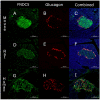Irisin-A Pancreatic Islet Hormone
- PMID: 35203466
- PMCID: PMC8869325
- DOI: 10.3390/biomedicines10020258
Irisin-A Pancreatic Islet Hormone
Abstract
Irisin is a myokine involved in glucose homeostasis. It is primarily expressed in skeletal muscle, but also in the pancreas. This study aimed to elucidate its presence and role in the islets of Langerhans-i.e., its effect on insulin and glucagon secretion as well as on blood flow in the pancreas. The precursor of irisin, fibronectin type III domain-containing protein 5 (FNDC5), was identified in rat and human islets by both qPCR and immunohistochemistry. Both α- and β-cells stained positive for FNDC5. In human islets, we found that irisin was secreted in a glucose-dependent manner. Neither irisin nor an irisin-neutralizing antibody affected insulin or glucagon secretion from human or rat islets in vitro. The insulin and glucagon content in islets was not altered by irisin. The intravenous infusion of irisin in Sprague Dawley rats resulted in nearly 50% reduction in islet blood flow compared to the control. We conclude that irisin is an islet hormone that has a novel role in pancreatic islet physiology, exerting local vascular effects by diminishing islet blood flow without affecting insulin secretion per se.
Keywords: blood flow; irisin; pancreatic islets; vascular.
Conflict of interest statement
The authors declare no conflict of interest.
Figures






References
-
- Kurdiova T., Balaz M., Vician M., Maderova D., Vlcek M., Valkovic L., Srbecky M., Imrich R., Kyselovicova O., Belan V., et al. Effects of obesity, diabetes and exercise on Fndc5 gene expression and irisin release in human skeletal muscle and adipose tissue: In vivo and in vitro studies. J. Physiol. 2014;592:1091–1107. doi: 10.1113/jphysiol.2013.264655. - DOI - PMC - PubMed
LinkOut - more resources
Full Text Sources

